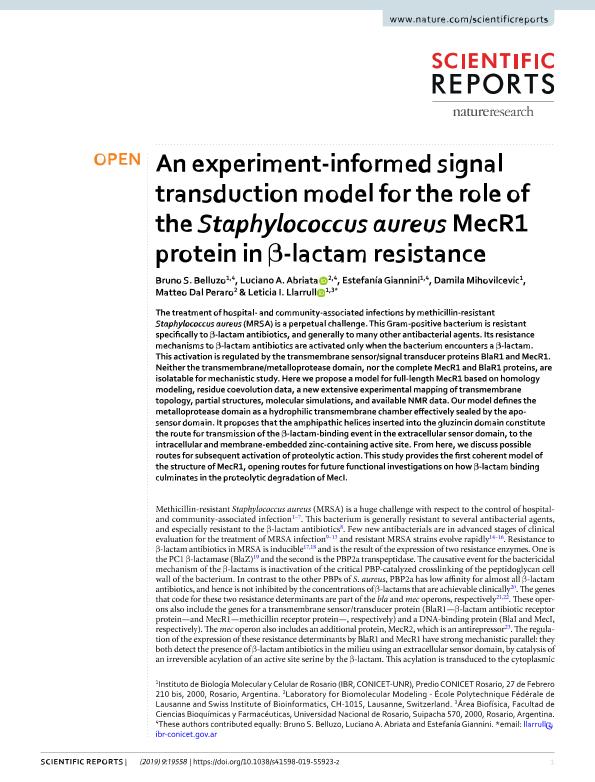Mostrar el registro sencillo del ítem
dc.contributor.author
Belluzo, Bruno Salvador

dc.contributor.author
Abriata, Luciano Andres

dc.contributor.author
Giannini, Estefanía

dc.contributor.author
Mihovilcevic, Damila

dc.contributor.author
Dal Peraro, Matteo
dc.contributor.author
Llarrull, Leticia Irene

dc.date.available
2022-03-16T01:48:41Z
dc.date.issued
2019-12
dc.identifier.citation
Belluzo, Bruno Salvador; Abriata, Luciano Andres; Giannini, Estefanía; Mihovilcevic, Damila; Dal Peraro, Matteo; et al.; An experiment-informed signal transduction model for the role of the Staphylococcus aureus MecR1 protein in β-lactam resistance; Nature Research; Scientific Reports; 9; 1; 12-2019; 19558-19572
dc.identifier.issn
2045-2322
dc.identifier.uri
http://hdl.handle.net/11336/153415
dc.description.abstract
The treatment of hospital- and community-associated infections by methicillin-resistant Staphylococcus aureus (MRSA) is a perpetual challenge. This Gram-positive bacterium is resistant specifically to β-lactam antibiotics, and generally to many other antibacterial agents. Its resistance mechanisms to β-lactam antibiotics are activated only when the bacterium encounters a β-lactam. This activation is regulated by the transmembrane sensor/signal transducer proteins BlaR1 and MecR1. Neither the transmembrane/metalloprotease domain, nor the complete MecR1 and BlaR1 proteins, are isolatable for mechanistic study. Here we propose a model for full-length MecR1 based on homology modeling, residue coevolution data, a new extensive experimental mapping of transmembrane topology, partial structures, molecular simulations, and available NMR data. Our model defines the metalloprotease domain as a hydrophilic transmembrane chamber effectively sealed by the apo-sensor domain. It proposes that the amphipathic helices inserted into the gluzincin domain constitute the route for transmission of the β-lactam-binding event in the extracellular sensor domain, to the intracellular and membrane-embedded zinc-containing active site. From here, we discuss possible routes for subsequent activation of proteolytic action. This study provides the first coherent model of the structure of MecR1, opening routes for future functional investigations on how β-lactam binding culminates in the proteolytic degradation of MecI.
dc.format
application/pdf
dc.language.iso
eng
dc.publisher
Nature Research
dc.rights
info:eu-repo/semantics/openAccess
dc.rights.uri
https://creativecommons.org/licenses/by-nc-sa/2.5/ar/
dc.subject
Staphylococcus aureus
dc.subject
MecR1
dc.subject
beta-lactam antibiotics
dc.subject.classification
Biofísica

dc.subject.classification
Ciencias Biológicas

dc.subject.classification
CIENCIAS NATURALES Y EXACTAS

dc.subject.classification
Bioquímica y Biología Molecular

dc.subject.classification
Ciencias Biológicas

dc.subject.classification
CIENCIAS NATURALES Y EXACTAS

dc.title
An experiment-informed signal transduction model for the role of the Staphylococcus aureus MecR1 protein in β-lactam resistance
dc.type
info:eu-repo/semantics/article
dc.type
info:ar-repo/semantics/artículo
dc.type
info:eu-repo/semantics/publishedVersion
dc.date.updated
2020-11-25T17:56:44Z
dc.journal.volume
9
dc.journal.number
1
dc.journal.pagination
19558-19572
dc.journal.pais
Reino Unido

dc.description.fil
Fil: Belluzo, Bruno Salvador. Consejo Nacional de Investigaciones Científicas y Técnicas. Centro Científico Tecnológico Conicet - Rosario. Instituto de Biología Molecular y Celular de Rosario. Universidad Nacional de Rosario. Facultad de Ciencias Bioquímicas y Farmacéuticas. Instituto de Biología Molecular y Celular de Rosario; Argentina
dc.description.fil
Fil: Abriata, Luciano Andres. Consejo Nacional de Investigaciones Científicas y Técnicas. Centro Científico Tecnológico Conicet - Rosario. Instituto de Biología Molecular y Celular de Rosario. Universidad Nacional de Rosario. Facultad de Ciencias Bioquímicas y Farmacéuticas. Instituto de Biología Molecular y Celular de Rosario; Argentina. École Polytechnique Fédérale de Lausanne; Suiza
dc.description.fil
Fil: Giannini, Estefanía. Consejo Nacional de Investigaciones Científicas y Técnicas. Centro Científico Tecnológico Conicet - Rosario. Instituto de Biología Molecular y Celular de Rosario. Universidad Nacional de Rosario. Facultad de Ciencias Bioquímicas y Farmacéuticas. Instituto de Biología Molecular y Celular de Rosario; Argentina
dc.description.fil
Fil: Mihovilcevic, Damila. Consejo Nacional de Investigaciones Científicas y Técnicas. Centro Científico Tecnológico Conicet - Rosario. Instituto de Biología Molecular y Celular de Rosario. Universidad Nacional de Rosario. Facultad de Ciencias Bioquímicas y Farmacéuticas. Instituto de Biología Molecular y Celular de Rosario; Argentina
dc.description.fil
Fil: Dal Peraro, Matteo. École Polytechnique Fédérale de Lausanne; Suiza
dc.description.fil
Fil: Llarrull, Leticia Irene. Consejo Nacional de Investigaciones Científicas y Técnicas. Centro Científico Tecnológico Conicet - Rosario. Instituto de Biología Molecular y Celular de Rosario. Universidad Nacional de Rosario. Facultad de Ciencias Bioquímicas y Farmacéuticas. Instituto de Biología Molecular y Celular de Rosario; Argentina
dc.journal.title
Scientific Reports
dc.relation.alternativeid
info:eu-repo/semantics/altIdentifier/doi/http://dx.doi.org/10.1038/s41598-019-55923-z
dc.relation.alternativeid
info:eu-repo/semantics/altIdentifier/url/https://www.nature.com/articles/s41598-019-55923-z
Archivos asociados
